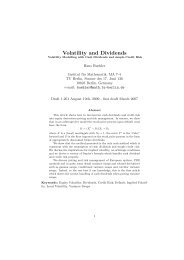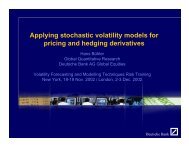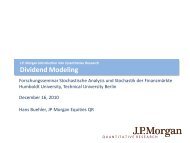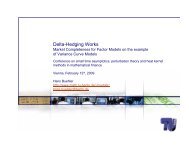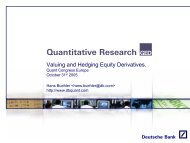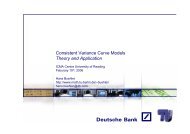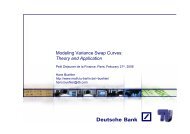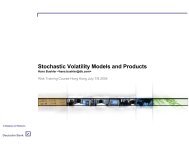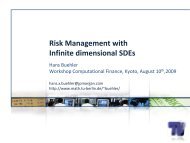Consistent Variance Curve Models - Hans Buehler
Consistent Variance Curve Models - Hans Buehler
Consistent Variance Curve Models - Hans Buehler
You also want an ePaper? Increase the reach of your titles
YUMPU automatically turns print PDFs into web optimized ePapers that Google loves.
<strong>Consistent</strong> <strong>Variance</strong> <strong>Curve</strong> <strong>Models</strong><br />
Technische Universität Wien<br />
October 17 th , 2005<br />
<strong>Hans</strong> <strong>Buehler</strong><br />
http://www.math.tu-berlin.de/~buehler/<br />
hans.buehler@db.com
<strong>Consistent</strong> <strong>Variance</strong> <strong>Curve</strong> <strong>Models</strong><br />
Outline<br />
• Introduction<br />
– Options on realized variance<br />
• <strong>Variance</strong> <strong>Curve</strong> <strong>Models</strong><br />
– General theory<br />
– Finite-dimensionally parameterized curves<br />
– <strong>Variance</strong> <strong>Curve</strong>s in a Hilbert space<br />
• Examples<br />
• Hedging
Realized <strong>Variance</strong><br />
Trading volatility
<strong>Consistent</strong> <strong>Variance</strong> <strong>Curve</strong> <strong>Models</strong><br />
Introduction<br />
• We are given an equity index (S&P, EuroSTOXX,…).<br />
• Listed options and complex OTC products are traded on S.<br />
– “Volatility” drives the price of such options.<br />
– Can we also trade “volatilty” ?<br />
• Well, we can trade realized variance.<br />
• It is typically computed over the business days 0=t 0
<strong>Consistent</strong> <strong>Variance</strong> <strong>Curve</strong> <strong>Models</strong><br />
Introduction<br />
• We will assume that S is continuous, that it pays no dividends and that the<br />
interest rates are zero. Hence, we may write it as<br />
S<br />
t<br />
dX<br />
t<br />
t<br />
( X − X )<br />
1<br />
= exp<br />
t 2<br />
= ζ<br />
dB<br />
t<br />
t<br />
on a stochastic base (Ω,P,F)<br />
– The one-dimensional Brownian motion B is adapted to the filtration F.<br />
– The short variance process ζ is a predictable, integrable and non-negative.<br />
• Realized variance is then the non-negative quantity<br />
log<br />
S<br />
T<br />
= ∫<br />
T ζ<br />
0<br />
s<br />
ds
Realized <strong>Variance</strong><br />
<strong>Variance</strong> Swaps<br />
• The simplest product on realized variance is a variance swap.<br />
• A variance swap is just a forward on realized variance:<br />
– At maturity T it pays the realized variance occurred during the life of the<br />
contract (usually in exchange for a previously agreed fixed strike K).<br />
– Such contracts are today liquidly traded on most major indices.<br />
In particular, their price processes are martingales under each equivalent<br />
martingale measure on (Ω,P,F).<br />
Let us assume that P is a martingale measure.<br />
– Then, the price V t<br />
(T) of a variance swap is just the expectation of the<br />
realized variance,<br />
V<br />
t<br />
( T )<br />
T<br />
= E⎡<br />
⎢⎣ ∫ ζ sds<br />
| Ft<br />
0<br />
⎤<br />
⎥⎦
Realized <strong>Variance</strong><br />
<strong>Variance</strong> Swaps<br />
• If European options are traded for all strikes, the price of a variance<br />
swap can in theory be computed in terms of European options using<br />
Neuberger’s (1990) formula,<br />
V<br />
0<br />
( T )<br />
=<br />
=<br />
=<br />
⎢⎣<br />
⎡ T<br />
+<br />
T<br />
1<br />
2 E − ∫ ζ<br />
0 s<br />
dBs<br />
2 ∫ζ<br />
0<br />
2 E[ ST<br />
−1−<br />
log ST<br />
]<br />
⎧ 1 1<br />
2⎨∫<br />
Put( T , K)<br />
dK +<br />
0 2<br />
⎩ K<br />
s<br />
ds⎤<br />
⎥⎦<br />
∫<br />
∞<br />
1<br />
K<br />
1 2<br />
⎫<br />
Call( T , K)<br />
dK⎬<br />
⎭<br />
– This works only if option prices are available for all T.<br />
• The formula probably contributes to the fact that variance swaps are<br />
now liquidly traded.<br />
– An excellent reference is Demeterfi et al (1999).
Realized <strong>Variance</strong><br />
<strong>Variance</strong> Swaps<br />
30.00<br />
Prices are quoted in “volatility”<br />
1<br />
∫ T ζ ds s<br />
T 0<br />
25.00<br />
<strong>Variance</strong> swap price (in volatility) 10/10/2005<br />
20.00<br />
15.00<br />
10.00<br />
.STOXX50E<br />
.SPX<br />
.FTSE<br />
5.00<br />
-<br />
01/09/2005 01/09/2006 01/09/2007 01/09/2008 01/09/2009 01/09/2010 01/09/2011 01/09/2012
Realized <strong>Variance</strong><br />
Beyond <strong>Variance</strong> Swaps<br />
• Since variance swaps are liquidly traded, there is no need to price them.<br />
• But what about more complex products:<br />
– Calls on realized variance<br />
– Volatility swaps<br />
⎜<br />
⎛<br />
⎝<br />
∫<br />
T<br />
ζ s<br />
0<br />
T<br />
ds<br />
−<br />
K<br />
2<br />
∫ζ s<br />
ds − K<br />
0<br />
+<br />
⎟<br />
⎞<br />
⎠<br />
– But also forward started options<br />
⎛<br />
⎜<br />
⎝<br />
S<br />
T<br />
2<br />
S<br />
T<br />
1<br />
+<br />
⎞<br />
− k ⎟<br />
⎠<br />
⎛ ⎛<br />
= ⎜exp⎜<br />
⎜ ⎜<br />
⎝ ⎝<br />
T<br />
∫<br />
T<br />
2<br />
1<br />
ζ<br />
s<br />
dB<br />
s<br />
−<br />
1<br />
2<br />
T<br />
∫<br />
T<br />
2<br />
1<br />
ζ<br />
s<br />
⎞<br />
ds⎟<br />
− k<br />
⎟<br />
⎠<br />
+<br />
⎞<br />
⎟<br />
⎟<br />
⎠
Realized <strong>Variance</strong><br />
Beyond <strong>Variance</strong> Swaps<br />
• The idea is to use the variance swaps themselves as underlying<br />
reference instruments.<br />
– A variance swap is a natural hedging instrument for such payoffs.<br />
– We can then attempt to hedge options on realized variance by deltahedging<br />
with variance swaps.<br />
• Mathematically, the term-structure of variance swaps reminds on the<br />
term-structure of discount bounds in interest rate models<br />
→ A term-structure problem is looming!
Realized <strong>Variance</strong><br />
Forward <strong>Variance</strong><br />
• <strong>Variance</strong> swap prices are increasing with maturity T.<br />
– Their price at a later time t also depends on the past realized variance.<br />
• To alleviate these unpleasant properties, note that<br />
V<br />
t<br />
T<br />
T<br />
( T ) = E⎡<br />
⎤<br />
∫ ζ =<br />
⎢⎣ ⎥⎦ ∫<br />
sds<br />
| Ft<br />
E ζ<br />
0<br />
0<br />
[ | F ]<br />
can be differentiated in T to define the forward variance<br />
s<br />
t<br />
ds<br />
v<br />
Observation time<br />
t<br />
( T ) : = ∂ V ( T)<br />
= E ζ<br />
T<br />
Maturity<br />
t<br />
[ | F ]<br />
T<br />
t<br />
– Note the similarity to the forward rate in interest rate theory.
Realized <strong>Variance</strong><br />
Modeling forward <strong>Variance</strong><br />
• Idea<br />
– Instead of starting with S, let us first specify the non-negative curve v.<br />
– Then, construct a (local) martingale S which has the correct quadratic<br />
variation.<br />
– The model shall also yield hedging ratios in terms of variance swaps.<br />
– The main difference is that forward variance can be zero for good<br />
economic reasons (holidays, suspended trading).<br />
Short variance also becomes zero for standard stochastic volatility models such<br />
as Heston’s.
<strong>Variance</strong> <strong>Curve</strong> <strong>Models</strong><br />
A structural approach
<strong>Variance</strong> <strong>Curve</strong> <strong>Models</strong><br />
Classic approach<br />
• First, we focus on the classical setup.<br />
Assume we have a driving d-dimensional extremal Brownian motion<br />
W on the space (Ω,P,F).<br />
• Definition<br />
A family v=(v(T)) T≥0 is called a <strong>Variance</strong> <strong>Curve</strong> Model if<br />
1. For each T>0, the process v(T)=(v t<br />
(T)) t∈[0,T]<br />
is a non-negative martingale:<br />
dv<br />
t<br />
j<br />
j j<br />
( T)<br />
= ∑ =<br />
β ( T ) dW β ( T)<br />
∈ L<br />
1, K,<br />
d<br />
2. For each T>0, the initial variance swap prices are finite, i.e.<br />
3. The curve v t<br />
(t) is left-continuous.<br />
j<br />
t<br />
V = ∫ T 0<br />
( T)<br />
v0(<br />
s)<br />
ds < ∞<br />
0<br />
t<br />
loc
<strong>Variance</strong> <strong>Curve</strong> <strong>Models</strong><br />
Classic approach<br />
• Properties<br />
– The price processes of variance swaps,<br />
are martingales.<br />
V<br />
t<br />
( T )<br />
:<br />
= ∫<br />
T vt<br />
0<br />
( s)<br />
ds<br />
– The short variance process<br />
ζ t<br />
: = v t<br />
( t)<br />
is well defined, integrable and non-negative.
<strong>Variance</strong> <strong>Curve</strong> <strong>Models</strong><br />
Classic approach<br />
• Properties<br />
Given any standard Brownian motion B on (Ω,P,F), the process<br />
is a square-integrable martingale, so the via B associated stock price<br />
is a local martingale.<br />
– B represents the correlation structure of S with v.<br />
• Theorem<br />
For each variance curve model v and each Brownian motion B, the market<br />
is free of arbitrage.<br />
dX<br />
t<br />
=<br />
ζ<br />
t<br />
dB<br />
( X X )<br />
1<br />
St<br />
: = exp<br />
t<br />
− 2<br />
( S ( V ( T))<br />
)<br />
;<br />
T ≥0<br />
t<br />
t
<strong>Variance</strong> <strong>Curve</strong> <strong>Models</strong><br />
Classic approach – Musiela-Parametrization<br />
• As in interest rates, it is more convenient to work with fixed time-tomaturities<br />
x:=T-t. Hence we define the Musiela parameterization<br />
vˆ<br />
( x) : = v<br />
( t<br />
t t<br />
+<br />
x)<br />
• Starting in Musiela-parametrization<br />
– Assume that<br />
Then,<br />
∑<br />
j=<br />
1,<br />
K,<br />
d 0<br />
∞<br />
∫ ∫<br />
t<br />
∞<br />
∂<br />
T<br />
β<br />
t<br />
( T )<br />
2<br />
dTdt<br />
< ∞<br />
dvˆ<br />
t<br />
( x) : = ∂<br />
x<br />
vˆ<br />
t<br />
( x)<br />
dt<br />
+∑ j =<br />
1, K,<br />
d<br />
β ˆ<br />
j<br />
t<br />
( x)<br />
dW<br />
t<br />
j<br />
defines a variance curve model in Musiela-parametrization.
<strong>Variance</strong> <strong>Curve</strong> <strong>Models</strong><br />
Classic approach – Fitting the market<br />
• If v is represented as an exponential,<br />
vˆ<br />
t<br />
( x)<br />
: =<br />
exp( wˆ<br />
t<br />
( x))<br />
it allows us to fit the model easily to an observed market forward<br />
variance curve u 0 by setting w 0 :=log u 0 .<br />
– This construction does not allow v to become zero.<br />
• A more convenient approach is to use an existing curve v base and set<br />
vˆ<br />
t<br />
( x)<br />
: =<br />
u<br />
vˆ<br />
( t + x)<br />
vˆ<br />
( t + x)<br />
(<br />
0 base<br />
base<br />
t<br />
x<br />
0<br />
)
<strong>Variance</strong> <strong>Curve</strong> <strong>Models</strong><br />
<strong>Variance</strong> <strong>Curve</strong> Functionals<br />
• Problems with a specification with general integrands β(T):<br />
– It is complicated to check whether v remains non-negative.<br />
– In practice, it is not clear how to handle such integrands computationally.<br />
• Hence, we want to write<br />
vˆ<br />
t<br />
( x) : =<br />
G(<br />
Z<br />
; x)<br />
for some suitable non-negative function G and an m-dimensional<br />
Markov-process Z.<br />
t
<strong>Variance</strong> <strong>Curve</strong> <strong>Models</strong><br />
<strong>Variance</strong> <strong>Curve</strong> Functionals<br />
• Definition<br />
1. A non-negative C 2,2 -function G:DxR + →R + is called a <strong>Variance</strong> <strong>Curve</strong><br />
Functional if<br />
∫ T G(<br />
z;<br />
x)<br />
dx < ∞<br />
0<br />
for all T and z∈D where D is an open set in R ≥0m<br />
.<br />
2. We denote by Ξ the set of all C=(µ,σ) for which the SDE<br />
dZ<br />
t<br />
=<br />
µ ( Z<br />
t<br />
) dt<br />
+∑ j =<br />
1, K,<br />
d<br />
σ<br />
j<br />
( Z<br />
t<br />
) dW<br />
t<br />
j<br />
starting at any point Z 0<br />
∈D has a unique solution Z which stays in D.
<strong>Variance</strong> <strong>Curve</strong> <strong>Models</strong><br />
<strong>Variance</strong> <strong>Curve</strong> Functionals<br />
• Definition<br />
We call C=(µ,σ)∈Ξ a consistent factor model for G if for any Z 0<br />
∈D,<br />
vt ( x) : =<br />
defines a variance curve model.<br />
G(<br />
Z<br />
; x)<br />
• Theorem<br />
This is the case if and only if Z stays in D and if<br />
ˆ<br />
t<br />
∂<br />
x<br />
G(<br />
z;<br />
x)<br />
= µ ( z)<br />
∂<br />
1<br />
G(<br />
z;<br />
x)<br />
+ σ<br />
2<br />
holds such that G(Z t<br />
;T-t) is a true martingale.<br />
z<br />
2<br />
( z)<br />
∂<br />
2<br />
zz<br />
G(<br />
z;<br />
x)
<strong>Variance</strong> <strong>Curve</strong> <strong>Models</strong><br />
<strong>Variance</strong> <strong>Curve</strong> Functionals<br />
• Remarks<br />
– For each consistent pair (G,C), we obviously have<br />
[ G(<br />
Z ;0) | Z z]<br />
G(<br />
z;<br />
x)<br />
E<br />
x<br />
=<br />
≡<br />
0<br />
– But our interest was asked the reverse question:<br />
given G, find a consistent C=(µ,σ)∈Ξ.<br />
• The next logical step is to model the curve v as a process with values in a<br />
Hilbert space H.<br />
– We follow the path laid by Bjoerk/Christensen (1999), Filipovic (2000),<br />
Filipovic/Teichmann (2004) and Teichmann (2005).
<strong>Variance</strong> <strong>Curve</strong> <strong>Models</strong><br />
Term-structure approach<br />
• The main difference between variance curve and forward curves is<br />
that the curves v must remain non-negative (but can become zero).<br />
– The problem is that the “non-negative cone” is a very small set.<br />
Indeed it has no interior points.<br />
– However, if G(D) is a sub-manifold with boundary of H, then it is sufficient<br />
to check whether v stays in G(D).<br />
In this case we say G(D) is locally invariant for v.<br />
– If G is moreover invertible, we can also directly construct a (locally)<br />
consistent factor model C=(µ,σ) for G.
<strong>Variance</strong> <strong>Curve</strong> <strong>Models</strong><br />
Term-structure approach<br />
• Assume that the variance curve v is given as a solution in H to<br />
dvˆ<br />
t<br />
= ∂<br />
x<br />
vˆ<br />
t<br />
dt<br />
+∑ j =<br />
1, K,<br />
d<br />
β ˆ<br />
j<br />
(ˆ v<br />
t<br />
) dW<br />
j<br />
t<br />
where the coefficients β are locally Lipschitz vector fields.<br />
• The Stratonovic-drift for v is as usual<br />
β<br />
0<br />
−∑<br />
j<br />
=<br />
Dβ<br />
( vˆ)<br />
⋅<br />
( v ˆ) : = ∂<br />
xvˆ<br />
β<br />
j 1, K,<br />
d<br />
j<br />
( vˆ)<br />
such that<br />
dvˆ<br />
t<br />
=<br />
βˆ<br />
0<br />
(ˆ v<br />
t<br />
) dt<br />
+∑ j =<br />
1, K,<br />
d<br />
βˆ<br />
j<br />
(ˆ v<br />
t<br />
) o<br />
dW<br />
t<br />
j
<strong>Variance</strong> <strong>Curve</strong> <strong>Models</strong><br />
Term-structure approach<br />
• Theorem (Filipovic/Teichmann 2004)<br />
The sub-manifold G(D) is locally invariant for v iff<br />
1. We have G(D)⊂dom(∂x),<br />
2. In the interior of G(D), we have<br />
βˆ<br />
j<br />
( vˆ)<br />
∈T<br />
vˆ<br />
G(<br />
D)<br />
j<br />
=<br />
0, K,<br />
d<br />
3. On the boundary ∂G(D),<br />
βˆ<br />
j<br />
βˆ<br />
0<br />
( vˆ)<br />
∈T<br />
( vˆ)<br />
∈ ( T<br />
vˆ<br />
vˆ<br />
∂G(<br />
D)<br />
G(<br />
D))<br />
≥0<br />
j = 1, K,<br />
d<br />
holds.
<strong>Variance</strong> <strong>Curve</strong> <strong>Models</strong><br />
Term-structure approach<br />
• If we can invert G, then C=(µ,σ) with<br />
µ ( z) : = ∂<br />
z<br />
G<br />
σ<br />
−1<br />
j<br />
( z) : = ∂<br />
( βˆ<br />
0<br />
z<br />
G<br />
( G(<br />
z))<br />
−1<br />
+<br />
( βˆ<br />
j<br />
∑ j = 1,.. d<br />
( G(<br />
z))<br />
( ∂<br />
z<br />
σ<br />
j<br />
)( z)<br />
σ<br />
j<br />
( z)<br />
is (locally) a consistent factor model for G.
Back to reality: A Simple Example<br />
Linear mean-reversion
<strong>Variance</strong> <strong>Curve</strong> <strong>Models</strong><br />
<strong>Variance</strong> <strong>Curve</strong> Functionals – Linear mean-reversion<br />
• Example<br />
A very basic example is the “linearly mean-reverting” functional:<br />
„Speed of mean-reversion“<br />
−z3x<br />
G( z;<br />
x)<br />
= z2<br />
+ ( z1<br />
− z2<br />
) e<br />
„Short variance“<br />
„Long variance“<br />
for z 1 ≥0 and z 2 ,z 3 >0.
<strong>Variance</strong> <strong>Curve</strong> <strong>Models</strong><br />
<strong>Variance</strong> <strong>Curve</strong> Functionals – Linear mean-reversion<br />
<strong>Variance</strong> Swap Term Structure .SPX 10/12/2005<br />
24<br />
22<br />
<strong>Variance</strong> Swap Fair Strike<br />
20<br />
18<br />
16<br />
Market<br />
Interpolation<br />
14<br />
12<br />
01/10/2005 01/10/2006 01/10/2007 01/10/2008 01/10/2009 01/10/2010 01/10/2011<br />
Maturity
<strong>Variance</strong> <strong>Curve</strong> <strong>Models</strong><br />
<strong>Variance</strong> <strong>Curve</strong> Functionals – Linear mean-reversion<br />
• Question: What dynamics can a consistent process Z=(Z 1<br />
, Z 2<br />
, Z 3<br />
) have?<br />
• The coefficients µ and σ have to satisfy<br />
∂<br />
G(<br />
z;<br />
x)<br />
=<br />
x<br />
µ ( z)<br />
∂<br />
z<br />
G(<br />
z;<br />
x)<br />
+<br />
1<br />
2<br />
σ<br />
2<br />
( z)<br />
∂<br />
2<br />
zz<br />
G(<br />
z;<br />
x)<br />
1. First, we see that<br />
∂<br />
2<br />
z<br />
3<br />
z<br />
3<br />
2 − z3x<br />
G(<br />
z;<br />
x)<br />
= ( z1<br />
− z2)<br />
x e<br />
Since no term x 2 e x appears on the left hand side, we must have σ 3 =0.<br />
2. The same line of thought applied to<br />
∂<br />
z<br />
−z3x<br />
G( z,<br />
x)<br />
= −( z1<br />
− z2<br />
xe<br />
3<br />
)<br />
shows that we also have µ 3 =0.<br />
Hence, the speed of mean-reversion cannot be stochastic.
<strong>Variance</strong> <strong>Curve</strong> <strong>Models</strong><br />
<strong>Variance</strong> <strong>Curve</strong> Functionals – Linear mean-reversion<br />
• For the other two parameters, we find that while σ is unconstrained,<br />
µ<br />
2<br />
( z)<br />
= 0<br />
µ ( z)<br />
= z<br />
1<br />
3<br />
( z<br />
2<br />
−<br />
z<br />
1<br />
)<br />
In other words: The only consistent processes for this choice of G<br />
are of Heston-type<br />
dζ<br />
dθ<br />
t<br />
t<br />
=<br />
=<br />
Mean-reversion level q is a<br />
positive martingale.<br />
κ ( θ<br />
σ<br />
2<br />
t<br />
( ζ<br />
−ζ<br />
t<br />
, θ<br />
t<br />
t<br />
Linear mean-reversion drift<br />
) dt<br />
) dW<br />
+ σ<br />
t<br />
1<br />
( ζ<br />
t<br />
, θ<br />
t<br />
) dW<br />
t<br />
VolOfVol can freely be<br />
chosen as long as z<br />
remains non-negative.
<strong>Variance</strong> <strong>Curve</strong> <strong>Models</strong><br />
Why mean-reversion?<br />
SPX Spot level and 30-day realized volatility<br />
2000<br />
100<br />
1800<br />
90<br />
1600<br />
SPX<br />
30-day vol<br />
Crash ‘87<br />
80<br />
1400<br />
70<br />
1200<br />
60<br />
Price<br />
1000<br />
50<br />
Volatility<br />
800<br />
40<br />
600<br />
30<br />
400<br />
20<br />
200<br />
10<br />
0<br />
07/10/1957 30/03/1963 19/09/1968 12/03/1974 02/09/1979 22/02/1985 15/08/1990 05/02/1996 28/07/2001 18/01/2007<br />
0
<strong>Variance</strong> <strong>Curve</strong> <strong>Models</strong><br />
Why mean-reversion?<br />
Heston path and 30-day realized volatility<br />
Unconstrained Calibration<br />
ShortVol 14.4%<br />
LongVol 28.7%<br />
RevSpeed 0.23<br />
Correlation -0.74<br />
VolOfVol 26.3%<br />
600<br />
100<br />
500<br />
Heston<br />
Heston Vol<br />
90<br />
80<br />
400<br />
70<br />
60<br />
Spot level<br />
300<br />
50<br />
Volatility<br />
40<br />
200<br />
30<br />
20<br />
100<br />
10<br />
0<br />
0<br />
1/14/2004 7/6/2009 12/27/2014 6/18/2020 12/9/2025 6/1/2031 11/21/2036
<strong>Variance</strong> <strong>Curve</strong> <strong>Models</strong><br />
<strong>Variance</strong> <strong>Curve</strong> Functionals<br />
• Proposition<br />
The observation that mean-reversion speeds must be constant holds for all<br />
polynomial-exponential functionals, i.e. if<br />
∑<br />
n<br />
1<br />
, K,<br />
zn<br />
, zn+ 1,.<br />
, zm;<br />
x)<br />
=<br />
i =<br />
pi(<br />
z;<br />
x)<br />
1<br />
G( z<br />
K<br />
−z<br />
x<br />
(where (p i<br />
) i<br />
are polynomials), then the first n components must be constant<br />
(cf. Filipovic 2001 for interest rates).<br />
e<br />
i<br />
• A similarly restrictive result can be shown for functionals of the form<br />
G(<br />
z<br />
, K,<br />
z<br />
, z<br />
+<br />
,. K,<br />
zm;<br />
x)<br />
=<br />
exp<br />
{ }<br />
n<br />
z x<br />
p ( z;<br />
x)<br />
e<br />
∑<br />
−<br />
1 n n 1<br />
i = 1 i<br />
i<br />
– The parameters in the exponent come in pairs, where one is twice as large as the<br />
other (again Filipovic 2001).
<strong>Variance</strong> <strong>Curve</strong> <strong>Models</strong><br />
<strong>Variance</strong> <strong>Curve</strong> Functionals – Example linear mean-reversion<br />
• Another example of the polynomial-exponential class is<br />
G<br />
−κx<br />
( z;<br />
x)<br />
= z3<br />
+ ( z1<br />
− z<br />
2)<br />
e + ( z2<br />
− z3)<br />
κ<br />
κ − c<br />
(<br />
−cx<br />
−κx<br />
e − e )<br />
– A consistent factor model for this G must have the form<br />
dZ<br />
dZ<br />
dZ<br />
1<br />
t<br />
2<br />
t<br />
3<br />
t<br />
=<br />
=<br />
=<br />
κ ( Z<br />
c(<br />
Z<br />
σ<br />
3<br />
2<br />
t<br />
3<br />
t<br />
( Z<br />
t<br />
− Z<br />
−<br />
Z<br />
1<br />
t<br />
2<br />
t<br />
) dW<br />
) dt<br />
) dt<br />
t<br />
+ σ<br />
+ σ<br />
1<br />
2<br />
( Z<br />
( Z<br />
t<br />
t<br />
) dW<br />
t<br />
) dW<br />
t<br />
which we call “double mean-reverting”.<br />
– Quite a good fit for most indices (at least during the course of the last year).
<strong>Variance</strong> <strong>Curve</strong> <strong>Models</strong><br />
<strong>Variance</strong> <strong>Curve</strong> Functionals – Example linear mean-reversion<br />
<strong>Variance</strong> Swap Term Structure .SPX 10/12/2005<br />
24<br />
22<br />
<strong>Variance</strong> Swap Fair Strike<br />
20<br />
18<br />
16<br />
14<br />
Market<br />
Heston<br />
Double Heston<br />
12<br />
01/10/2005 01/10/2006 01/10/2007 01/10/2008 01/10/2009 01/10/2010 01/10/2011<br />
Maturity
Hedging<br />
Using <strong>Variance</strong> <strong>Curve</strong> <strong>Models</strong> to hedge Options on <strong>Variance</strong>
Hedging<br />
How to hedge with variance curve models<br />
• We are back in our initial classical setting, i.e. we have decided to<br />
use a consistent variance curve model,<br />
dZ<br />
t<br />
=<br />
vˆ<br />
t<br />
( x)<br />
=<br />
( Z<br />
t<br />
) dt<br />
G(<br />
Z<br />
+∑ j =<br />
t<br />
; x)<br />
1, K,<br />
d<br />
σ<br />
j<br />
( Z<br />
t<br />
) dW<br />
j<br />
t<br />
µ<br />
ζ<br />
t<br />
: = vˆ<br />
t<br />
(0)<br />
⎡<br />
⎜ ⎟<br />
⎞<br />
⎢⎣<br />
⎛ T<br />
E h ∫ ⎥ ⎤<br />
sds<br />
Ft<br />
⎝<br />
ζ 0 ⎠ ⎦<br />
• We want to price and hedge an “option on realized variance” with<br />
(bounded) European payoff h. Its price process is given as
Hedging<br />
How to hedge with variance curve models<br />
• Define the variance swap price function<br />
G ( z;<br />
x)<br />
and assume that there exist constant 0
Hedging<br />
How to hedge with variance curve models<br />
• Due to the Markov-property of Z, we have<br />
Running realized variance<br />
C<br />
t<br />
( Z<br />
t<br />
, V<br />
t<br />
( t))<br />
T<br />
: = E<br />
⎡<br />
h⎜<br />
⎛<br />
⎟<br />
⎞ ⎤<br />
⎢⎣ ⎝∫ ζ<br />
sds<br />
Zt<br />
; Vt<br />
( t)<br />
0 ⎠ ⎥⎦<br />
• To hedge this payoff in the interval [a,b], we can write it due to our<br />
assumptions on G as<br />
C<br />
t<br />
( Z , V ( t))<br />
≡ C ( V ( T1 ), K,<br />
V ( T ), V ( t))<br />
t<br />
t<br />
t<br />
such that (under the assumption that C is smooth enough)<br />
t<br />
t<br />
m<br />
t<br />
dC<br />
t<br />
m<br />
( L)<br />
= ∑ =<br />
∂ C ( L)<br />
dV<br />
k<br />
1<br />
V<br />
k<br />
t<br />
t<br />
( T<br />
k<br />
)
Hedging<br />
How to hedge with variance curve models<br />
• This<br />
dC<br />
t<br />
m<br />
( L)<br />
= ∑ =<br />
∂ C ( L)<br />
dV<br />
k<br />
1<br />
V<br />
k<br />
t<br />
t<br />
( T<br />
k<br />
)<br />
is the desired hedge of h in terms of variance swaps.<br />
– For options on variance, this is a “natural” hedge.<br />
– It can also be used for standard options (a delta-term will appear).<br />
– For forward started options, correlation (skew) risk should be taken into<br />
account.<br />
• In practise, the above “VarSwapDelta” hedging ratios are computed via<br />
bumping of the variance swap price.
<strong>Variance</strong> <strong>Curve</strong>s<br />
Future
<strong>Variance</strong> <strong>Curve</strong>s<br />
Future<br />
• Challenges ahead<br />
– Incorporation of stochastic interest rates and dividends<br />
(in particular long-term deals could exhibit strong exposure to stochastic<br />
interest rates).<br />
– Jumps both in the underlying and the variance process<br />
(witness S&P return graph earlier).<br />
– Correlation between the variance curves between different underlyings<br />
(our suspicion is that it is actually quite high).<br />
• The dream, however, is to characterize the entire implied volatility<br />
surface or, equivalently, the “forward probability distribution” of S.
Thank you very much for your attention.<br />
Working paper and at http://www.math.tu-berlin.de/~buehler/
References<br />
– T.Bjoerk, B. Christenssen: "Interest rate dynamics and consistent forward rate<br />
curves", Mathematical Finance, 9:4, 323-348, 1999.<br />
– H.<strong>Buehler</strong>; “Volatility Markets: <strong>Consistent</strong> modelling, hedging and practical<br />
implementation”, TU Berlin, PhD thesis, to be submitted.<br />
– B.Dupire: “Arbitrage Pricing with Stochastic Volatility", Derivatives Pricing, p.197-<br />
215, Risk 2004<br />
– D.Filipovic, Consistency Problems for Heath-Jarrow-Morton Interest Rate <strong>Models</strong><br />
(Lecture Notes in Mathematics 1760), Springer-Verlag, Berlin, 2001<br />
– D.Filipovic, J.Teichmann: “Existence of invariant Manifolds for Stochastic Equations<br />
in infinite dimension”, Journal of Functional Analysis 197, 398-432, 2003.<br />
– D.Filipovic, J.Teichmann: “On the Geometry of the Term structure of Interest<br />
Rates”, Proceedings of the Royal Society London A 460, 129-167, 2004.<br />
– S. Heston: “A closed-form solution for options with stochastic volatility with<br />
applications to bond and currency options", Review of Financial Studies, 1993<br />
– A.Neuberger: “Volatility Trading", London Business School WP (1999)





